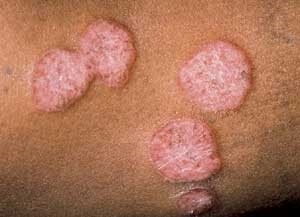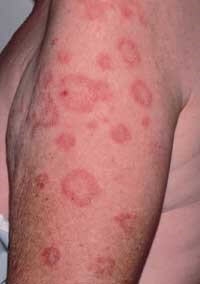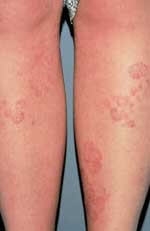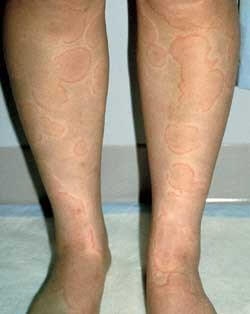Ring-shaped skin lesions, which often occur without symptoms that frighten the patient and do not cause him discomfort, can become the first harbingers of severe, often incurable diseases. Skin lesions caused by diseases of this type are usually inflammatory in nature, manifested by papules, rashes or plaques, and may spontaneously disappear or recur. Timely diagnosis of the disease that caused ring-shaped skin lesions will help you choose the best treatment tactics, which you can read about on estet-portal.com.
The most severe diseases, manifested by ring-shaped skin lesions
The course of diseases manifested by ring-shaped skin lesions can be very severe and almost asymptomatic, when only elements of a rash can help the doctor to suspect disease and prescribe additional diagnostic measures.

Sarcoidosis – idiopathic disease of a multisystem nature, in which permanent granulomas develop in various organs and systems. The lungs, liver, spleen, salivary glands, and lymph nodes are most commonly affected. The highest risk of developing sarcoidosis with lesions of the skin and internal organs in people at a young age – from 20 to 40 years old.
The course of the disease can vary from asymptomatic to fulminant. Typical manifestations of skin lesions in sarcoidosis are infiltrated papules and plaques, subcutaneous nodes. Papules are purple or brown, 1-3 cm in diameter, they can be detected primarily on mucous membranes and on the face – predominantly in the periorbital zone and in the region of the nasolabial folds. Large plaques may coalesce to form ring-shaped skin lesions.
The diagnosis of sarcoidosis is made on the basis of clinical findings and the results of histological and radiological examinations.
Bilateral hilar lymphadenopathy is practically considered pathognomonic for sarcoidosis.
When sarcoidosis is suspected, it is important to evaluate the patient for skin lesions that can be readily biopsied without the need for invasive diagnostic procedures. As a rule, histological confirmation of the diagnosis can be obtained using swabs from the bronchoalveolar tree and by performing a transbronchial lung biopsy.
Sarcoidosis is an incurable disease, but it is necessary to alleviate its course to the patient. For this, systemic corticosteroids are used. A direct indication for their appointment is the presence of a cough and shortness of breath in the patient, which incapacitates the course of the disease. If skin lesions are localized, topical corticosteroids or injections into lesions may be used. In case of intolerance or resistance to corticosteroids, methotrexate or thalidomide may be prescribed.

Subacute cutaneous lupus erythematosus usually presents as an annular or psoriasomorphic rash. An important diagnostic feature of the disease is sensitivity to light – usually elements of the rash are found on open parts of the body where the sun hits. Patients with cutaneous lupus erythematosus usually have:
- inflammation of the joints,
- slight temperature increase,
- feeling unwell,
- frequent myalgias.
Subacute cutaneous lupus erythematosus is a systemic disease of mild or moderate severity, the kidneys are rarely affected in this disease.
Annular skin lesions not requiring specific treatment
Some diseases characterized by ring-shaped skin lesions do not require treatment, as they resolve on their own over time. However, if the patient feels unwell – when he complains of itching, malaise, or is preoccupied with skin defects – symptomatic therapy is prescribed.

Annular centrifugal erythema has such characteristic features as ring-shaped spots with peeling observed within the erythematous margins. Skin lesions occur most often on the buttocks, thighs, and legs, and the hands, feet, and face remain clear of the rash. The disease may recur.
Diagnosis of annular centrifugal erythema is based on clinical and morphological criteria. The illness can last from several weeks to several years. Specific therapy is not usually required, but if the primary disease causing erythema annulare is known, treatment should not be delayed. Topical or systemic corticosteroids, antihistamines will help relieve itching.

Urticaria is manifested by severe itching and the appearance of erymatous blisters of a clear shape, smooth and clean in the center and with raised, inflamed edges.
Urticaria is diagnosed in 10-20% of the population, but it is difficult to say how common this condition is in reality, since many patients with a rash that clears up on its own after a short time do not seek medical help.
Depending on the etiology of the disease, allergic and physical urticaria are distinguished.
- Allergic urticaria is caused by plant pollen, some foods and medicines, fungi and parasites.
- Physical urticaria includes rash from wearing tight clothing or from skin exposure to heavy loads, cold, cholinergic, solar, and dermatographic allergies.
Usually, with urticaria, the rash persists on the skin from an hour and a half to a day. Under the influence of powerful antihistamines, blisters on the skin are significantly reduced, but usually do not disappear completely.







Add a comment